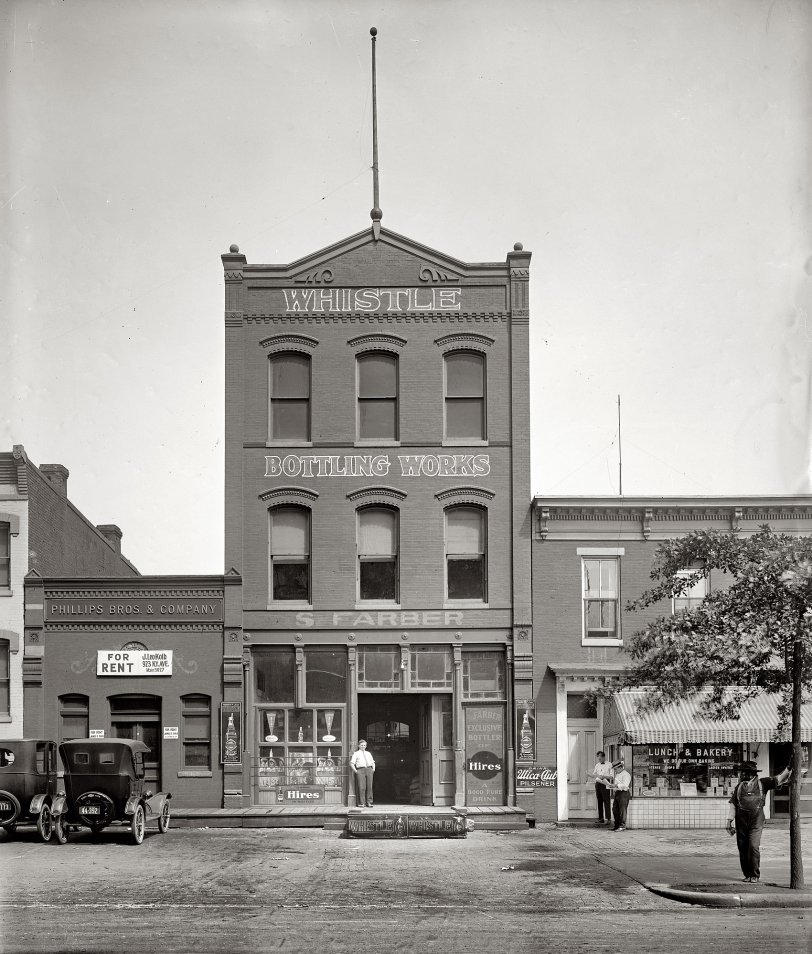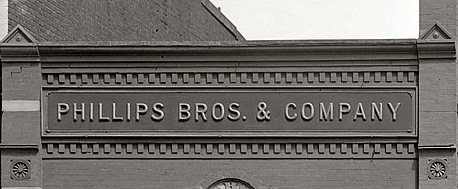


Framed or unframed, desk size to sofa size, printed by us in Arizona and Alabama since 2007. Explore now.
Shorpy is funded by you. Patreon contributors get an ad-free experience.
Learn more.

- Roll your own
- Rugged and real!
- A Charles Purcell - Mama Cass Connection
- Uncle SAAM
- Obfuscation
- One Chocolate Soldier rode away
- Victor Marquis de la Roche
- The Little House Across Way ...
- Vanderbilt Gates
- Vanderbilt Mansion
- You can still see that gate
- Withering heights for me
- So Jim,
- Top Heavy
- Re: Can't Place It.
- Bus ID
- Since you mention it
- The White Pages ?
- Moonlight Tower
- 1907?
- Fire(men) and Water
- Can't Place It
- Can anyone
- Wings
- Where's Claudette and Clark?
- Overbuilt Rolodex
- One song
- Give Me Wings Please!
- PRR
- Pinball Wizards
Printporium
Whistle Bottling Works: 1925

"Whistle Bottling Works." The Whistle beverage plant in Washington, D.C., in 1925. View full size. National Photo Company Collection glass negative.
Phillips Bros. & Company
Advertisement, Washington Post, Oct 8, 1920Have You Tasted
Phillips' Old Time Sausage
all pork and a perfect blend.
Made from the finest quality of pork and spices under the supervision of experts. Now on sale in all markets and leading grocer and meat stores. Specify "OLD TIME" if you want the best. There's none just as good.
manufactured only byPhillips BROS. & CO.
Factory at 705 N. Capitol St.
Telephone Main 5926
Advertisement, Washington Post, Dec 24, 1920Is It Clean?
Some sausage is made under the cleanest of conditions and from the choicest of pork and some isn't. OURS IS!
If you don't believe it, drop into our plant at 705 N. Capitol Street any old time and see
Phillips' Old Time Sausage
in the makeing. IT'S sold in the green wrapper.
Phillips Brothers & Co.
704 N. Capitol St.
Telephone Main 5926

On that block
In 1925, my grandfather and his brothers had the "P.O. Visible Lunch" on that block at 727 North Capitol, so named because it was between the Post Office and the Government Printing Office.
"Visible Lunch" referred to the glass-front cases that allowed customers to watch food being prepared; my dad always told me it was one of D.C.'s first cafeterias.
Any pictures of the P.O., Dave?
[We have pics of the City Post Office here, here, here and here. - Dave]
Hi-res Bottling
You know you've been geeking around with computer graphics for too long when you see a sign for Hires pop and instantly read it as "Hi-res".
Area Brews and such
The big DC brewer was Christian Heurich but the local beer center was Baltimore, which had dozens of breweries in the '50s and still had five (including the brand-new Carling plant) in the mid '60s. There was also the huge Calvert distillery on the south side of town and a Seagram's facility in Dundalk. Everything is gone now.
Utica Club
Interestingly, Prohibition had been in place since 1920 and continued until 1933. Yet, the building has an advertising sign for Utica Club Pilsener, which sounds like beer to me. I can't imagine that they were selling it out in the open or that they were selling it at all. Was it just nostalgia or were they expecting the repeal momentarily. The "ladies welcome" sign may have been code for "not a speakeasy."
[Low-alcohol beers and malts were legal during Prohibition. Utica Club Pilsener was marketed as a soft drink. "Ladies welcome" and "Tables for Ladies" was common restaurant signage from the early part of the century into the 1940s. - Dave]
Home Brew
When I was roughly Jr. High/early High School age, a friend's mother made root beer at home. I don't recall anything exploding, but then she was a Home Economics teacher and knew how to follow a recipe. The stuff wasn't all that great, but it was free, so who was I to complain?
Ladies Welcome
The luncheonette on the right has "ladies welcome" on its window... were there some luncheonettes just for men back then? Why would they put that on their window?
[Eating alone (or without a male escort) in a restaurant was something a lot of women had never done before, or felt uncomfortable doing. - Dave]
Whiskey Bottling Works...
...is how I originally read the title of this post. "Ah, for the days when they distilled American whiskey somewhere other than Kentucky" was going to be my comment. It wasn't until I saw the Hires logo that I realized I'd misread the title.
I know I'm not as cask-conditioned as some of the commenters here, but I am old enough to remember when you could buy the Hires kits and make root beer at home. I always wanted to get my parents to buy some Hires extract, but they had too many horror stories of perfectly good closets ruined by exploding bottles of home-brewed root beer.
Were there any distillers in pre-Prohibition D.C.? I'm fairly new to Shorpy, so maybe you've posted some previously.
[Arlington Brewery is the closest thing I can think of. My dad and his brother tried making root beer at home when they were kids. Their glass gallon jugs exploded in the attic. Too much yeast, Dad said. - Dave]
703 North Capitol
This appears to be a recently opened bottling plant at 703 North Capitol Street. Papers as late as February 1925 list Whistle Bottling Works at Fourth and F Street Northeast (possible the same facility as the old Jueneman/Carry brewery). However, by the summer of 1926, S. Farber was bottling Green River ("The Snappy Lime Drink") at 703 North Capitol NW. Consistent with this is a 1922 ad for Phillips Bros. & Co (Sausage, Smoked Ham, Bacon, Cooked Ham, Frankfurters) at 705 North Capitol.
This complex saw earlier use (circa 1900) as a Pabst brewery. Indeed the top edge of a "Pabst" seal appears visible behind the For Rent sign at #705.
#705 was also site of Plaza Wine and Liquor which was owned and operated by H. Gilmour (Gillie) Young from 1934 to 1980.
Now this entire block is high-end office space.
























On Shorpy:
Today’s Top 5